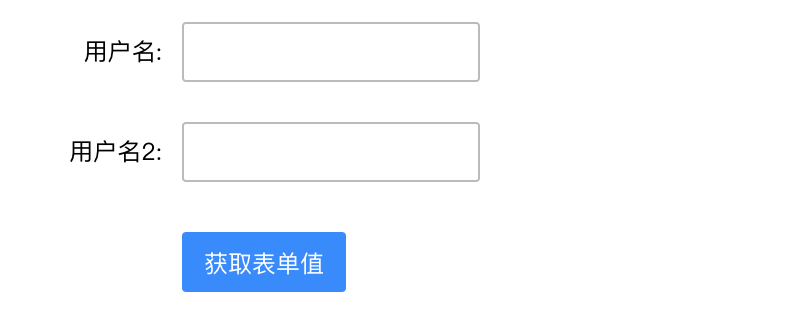前言
对于网页系统来说,表单提交是一种很常见的与用户交互的方式,比如提交订单的时候,需要输入收件人、手机号、地址等信息,又或者对系统进行设置的时候,需要填写一些个人偏好的信息。 表单提交是一种结构化的操作,可以通过封装一些通用的功能达到简化开发的目的。本文将讨论Form表单组件设计的思路,并结合有赞的ZentForm组件介绍具体的实现方式。本文所涉及的代码都是基于React v15的版本。
Form组件功能
一般来说,Form组件的功能包括以下几点:
- 表单布局
- 表单字段
- 封装表单验证&错误提示
- 表单提交
下面将对每个部分的实现方式做详细介绍。
表单布局
常用的表单布局一般有3种方式:
行内布局

水平布局

垂直布局

实现方式比较简单,嵌套css就行。比如form的结构是这样:
<form class="form"> <label class="label"/> <field class="field"/> </form>
对应3种布局,只需要在form标签增加对应的class:
<!--行内布局--> <form class="form inline"> <label class="label"/> <field class="field"/> </form> <!--水平布局--> <form class="form horizontal"> <label class="label"/> <field class="field"/> </form> <!--垂直布局--> <form class="form vertical"> <label class="label"/> <field class="field"/> </form>
相应的,要定义3种布局的css:
.inline .label {
display: inline-block;
...
}
.inline .field {
display: inline-block;
...
}
.horizontal .label {
display: inline-block;
...
}
.horizontal .field {
display: inline-block;
...
}
.vertical .label {
display: block;
...
}
.vertical .field {
display: block;
...
}
表单字段封装
字段封装部分一般是对组件库的组件针对Form再做一层封装,如Input组件、Select组件、Checkbox组件等。当现有的字段不能满足需求时,可以自定义字段。
表单的字段一般包括两部分,一部分是标题,另一部分是内容。ZentForm通过getControlGroup这一高阶函数对结构和样式做了一些封装,它的入参是要显示的组件:
export default Control => {
render() {
return (
<div className={groupClassName}>
<label className="zent-form__control-label">
{required ? <em className="zent-form__required">*</em> : null}
{label}
</label>
<div className="zent-form__controls">
<Control {...props} {...controlRef} />
{showError && (
<p className="zent-form__error-desc">{props.error}</p>
)}
{notice && <p className="zent-form__notice-desc">{notice}</p>}
{helpDesc && <p className="zent-form__help-desc">{helpDesc}</p>}
</div>
</div>
);
}
}
这里用到的label和error等信息,是通过Field组件传入的:
<Field
label="预约门店:"
name="dept"
component={CustomizedComp}
validations={{
required: true,
}}
validationErrors={{
required: '预约门店不能为空',
}}
required
/>
这里的CustomizedComp是通过getControlGroup封装后返回的组件。
字段与表单之间的交互是一个需要考虑的问题,表单需要知道它包含的字段值,需要在适当的时机对字段进行校验。ZentForm的实现方式是在Form的高阶组件内维护一个字段数组,数组内容是Field的实例。后续通过操作这些实例的方法来达到取值和校验的目的。
ZentForm的使用方式如下:
class FieldForm extends React.Component {
render() {
return (
<Form>
<Field
name="name"
component={CustomizedComp}
</Form>
)
}
}
export default createForm()(FieldForm);
其中Form和Field是组件库提供的组件,CustomizedComp是自定义的组件,createForm是组件库提供的高阶函数。在createForm返回的组件中,维护了一个fields的数组,同时提供了attachToForm和detachFromForm两个方法,来操作这个数组。这两个方法保存在context对象当中,Field就能在加载和卸载的时候调用了。简化后的代码如下:
/**
* createForm高阶函数
*/
const createForm = (config = {}) => {
...
return WrappedForm => {
return class Form extends Component {
constructor(props) {
super(props);
this.fields = [];
}
getChildContext() {
return {
zentForm: {
attachToForm: this.attachToForm,
detachFromForm: this.detachFromForm,
}
}
}
attachToForm = field => {
if (this.fields.indexOf(field) < 0) {
this.fields.push(field);
}
};
detachFromForm = field => {
const fieldPos = this.fields.indexOf(field);
if (fieldPos >= 0) {
this.fields.splice(fieldPos, 1);
}
};
render() {
return createElement(WrappedForm, {...});
}
}
}
}
/**
* Field组件
*/
class Field extends Component {
componentWillMount() {
this.context.zentForm.attachToForm(this);
}
componentWillUnmount() {
this.context.zentForm.detachFromForm(this);
}
render() {
const { component } = this.props;
return createElement(component, {...});
}
}
当需要获取表单字段值的时候,只需要遍历fields数组,再调用Field实例的相应方法就可以:
/**
* createForm高阶函数
*/
const createForm = (config = {}) => {
...
return WrappedForm => {
return class Form extends Component {
getFormValues = () => {
return this.fields.reduce((values, field) => {
const name = field.getName();
const fieldValue = field.getValue();
values[name] = fieldValue;
return values;
}, {});
};
}
}
}
/**
* Field组件
*/
class Field extends Component {
getValue = () => {
return this.state._value;
};
}
表单验证&错误提示
表单验证是一个重头戏,只有验证通过了才能提交表单。验证的时机也有多种,如字段变更时、鼠标移出时和表单提交时。ZentForm提供了一些常用的验证规则,如非空验证,长度验证,邮箱地址验证等。当然还能自定义一些更复杂的验证方式。自定义验证方法可以通过两种方式传入ZentForm,一种是通过给createForm传参:
createForm({
formValidations: {
rule1(values, value){
},
rule2(values, value){
},
}
})(FormComp);
另一种方式是给Field组件传属性:
<Field
validations={{
rule1(values, value){
},
rule2(values, value){
},
}}
validationErrors={{
rule1: 'error1',
rule2: 'error2'
}}
/>
使用createForm传参的方式,验证规则是共享的,而Field的属性传参是字段专用的。validationErrors指定校验失败后的提示信息。这里的错误信息会显示在前面getControlGroup所定义HTML中{showError && (<p className="zent-form__error-desc">{props.error}</p>)}
ZentForm的核心验证逻辑是createForm的runRules方法,
runRules = (value, currentValues, validations = {}) => {
const results = {
errors: [],
failed: [],
};
function updateResults(validation, validationMethod) {
// validation方法可以直接返回错误信息,否则需要返回布尔值表明校验是否成功
if (typeof validation === 'string') {
results.errors.push(validation);
results.failed.push(validationMethod);
} else if (!validation) {
results.failed.push(validationMethod);
}
}
Object.keys(validations).forEach(validationMethod => {
...
// 使用自定义校验方法或内置校验方法(可以按需添加)
if (typeof validations[validationMethod] === 'function') {
const validation = validations[validationMethod](
currentValues,
value
);
updateResults(validation, validationMethod);
} else {
const validation = validationRules[validationMethod](
currentValues,
value,
validations[validationMethod]
);
}
});
return results;
};
默认的校验时机是字段值改变的时候,可以通过Field的validateOnChange和validateOnBlur来改变校验时机。
<Field
validateOnChange={false}
validateOnBlur={false}
validations={{
required: true,
matchRegex: /^[a-zA-Z] $/
}}
validationErrors={{
required: '值不能为空',
matchRegex: '只能为字母'
}}
/>
对应的,在Field组件中有2个方法来处理change和blur事件:
class Field extends Component {
handleChange = (event, options = { merge: false }) => {
...
this.setValue(newValue, validateOnChange);
...
}
handleBlur = (event, options = { merge: false }) => {
...
this.setValue(newValue, validateOnBlur);
...
}
setValue = (value, needValidate = true) => {
this.setState(
{
_value: value,
_isDirty: true,
},
() => {
needValidate && this.context.zentForm.validate(this);
}
);
};
}
当触发验证的时候,ZentForm是会对表单对所有字段进行验证,可以通过指定relatedFields来告诉表单哪些字段需要同步进行验证。
表单提交
表单提交时,一般会经历如下几个步骤
- 表单验证
- 表单提交
- 提交成功处理
- 提交失败处理
ZentForm通过handleSubmit高阶函数定义了上述几个步骤,只需要传入表单提交的逻辑即可:
const handleSubmit = (submit, zentForm) => {
const doSubmit = () => {
...
result = submit(values, zentForm);
...
return result.then(
submitResult => {
...
if (onSubmitSuccess) {
handleOnSubmitSuccess(submitResult);
}
return submitResult;
},
submitError => {
...
const error = handleSubmitError(submitError);
if (error || onSubmitFail) {
return error;
}
throw submitError;
}
);
}
const afterValidation = () => {
if (!zentForm.isValid()) {
...
if (onSubmitFail) {
handleOnSubmitError(new SubmissionError(validationErrors));
}
} else {
return doSubmit();
}
};
const allIsValidated = zentForm.fields.every(field => {
return field.props.validateOnChange || field.props.validateOnBlur;
});
if (allIsValidated) {
// 不存在没有进行过同步校验的field
afterValidation();
} else {
zentForm.validateForm(true, afterValidation);
}
}
使用方式如下:
const { handleSubmit } = this.props;
<Form onSubmit={handleSubmit(this.submit)} horizontal>
ZentForm不足之处
ZentForm虽然功能强大,但仍有一些待改进之处:
- 父组件维护了所有字段的实例,直接调用实例的方法来取值或者验证。这种方式虽然简便,但有违React声明式编程和函数式编程的设计思想,并且容易产生副作用,在不经意间改变了字段的内部属性。
- 大部分的组件重使用了shouldComponentUpdate,并对state和props进行了深比较,对性能有比较大的影响,可以考虑使用PureComponent。
- 太多的情况下对整个表单字段进行了校验,比较合理的情况应该是某个字段修改的时候只校验本身,在表单提交时再校验所有的字段。
- 表单提交操作略显繁琐,还需要调用一次handleSubmit,不够优雅。
结语
本文讨论了Form表单组件设计的思路,并结合有赞的ZentForm组件介绍具体的实现方式。ZentForm的功能十分强大,本文只是介绍了其核心功能,另外还有表单的异步校验、表单的格式化和表单的动态添加删除字段等高级功能都还没涉及到,感兴趣的朋友可点击前面的链接自行研究。
希望阅读完本文后,你对React的Form组件实现有更多的了解,也欢迎留言讨论。